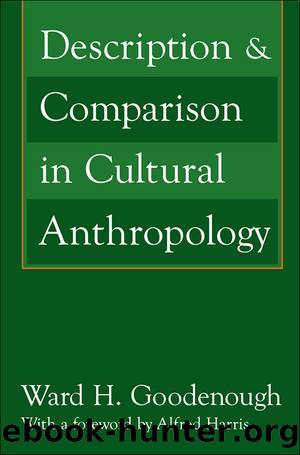Description and Comparison in Cultural Anthropology by Alfred Harris

Author:Alfred Harris [Harris, Alfred]
Language: eng
Format: epub
ISBN: 9780202308616
Barnesnoble:
Publisher: Transaction Publishers
Published: 2006-11-15T00:00:00+00:00
Consideration of similarity and difference of sex can apply to positions in the consanguineal chain between ego and alter. Thus in relationships in which ego and alter are one generation distant and in which there are no marital ties in the junior generation of the relationship, the Lakalai distinguish three reciprocal sets of terms, which we may label A, B, and C. Their respective ranges of denotata are given in Figure 5. Inspection of these denotata reveals that the relationships in set A are set off from those in sets B and C by virtue of the presence in B and C of a sex difference between the consanguineally related pair in the genealogical chain in the first ascending generation of the relationship (the generation immediately senior to that of the junior party to the relationship). The sex of the linking parent of the junior party does not in itself account for the data. In set B, for example, the linking parent may be male or female; the constant is the difference of sex.
Consideration of the similarity and difference of sex of pairs of mediating relatives prepares us to understand the terminology of Moala in Fiji (Sahlins 1962). Here, according to my analysis (Goodenough 1968), a distinction is based on the number of coeval pairs of opposite sex in the generations in the genealogical chain other than in the youngest generation. To this number is added the number of marital ties in the youngest generation. If the combined number is odd, ego and alter are in one kind of relationship; if the combined number is even, they are in the other kind of relationship (Figure 6). It sounds horribly complicated, but in reckoning to a distant relative it is very simple if you use a common relative whose relationship to each of you is already known. Then the rule is that the even of my even is my even, as is the odd of my odd; but the even of my odd is my odd, as is the odd of my even. As marriages take place or new children are borne, one need only look to see whether or not the new relative adds a marital tie that counts or a coeval sex difference that matters. If one thinks of similarity and difference of sex as involving notions of symmetry and asymmetry, and if one thinks of oddness and evenness as involving the same notions of symmetry and asymmetry; then the Moala terminology becomes one in which symmetry appears at a more abstract level as an underlying criterion of classification.
The Moala case is especially interesting, because it represents a distribution of kinship terms that anthropologists have assumed made sense only given the presence of unilineal moieties that exchanged women in marriage. In an extended review of Sahlinsâ book, Groves (1963b) makes this the hub of his critique, arguing that Sahlins has not understood his Moala data correctly and has failed to appreciate that he is dealing with a pattern of marital exchanges or alliances between sets of agnates.
Download
This site does not store any files on its server. We only index and link to content provided by other sites. Please contact the content providers to delete copyright contents if any and email us, we'll remove relevant links or contents immediately.
Cecilia; Or, Memoirs of an Heiress — Volume 1 by Fanny Burney(32503)
Cecilia; Or, Memoirs of an Heiress — Volume 2 by Fanny Burney(31913)
Cecilia; Or, Memoirs of an Heiress — Volume 3 by Fanny Burney(31900)
The Great Music City by Andrea Baker(31761)
We're Going to Need More Wine by Gabrielle Union(19004)
All the Missing Girls by Megan Miranda(15788)
Pimp by Iceberg Slim(14440)
Bombshells: Glamour Girls of a Lifetime by Sullivan Steve(14024)
For the Love of Europe by Rick Steves(13643)
Talking to Strangers by Malcolm Gladwell(13300)
Norse Mythology by Gaiman Neil(13284)
Fifty Shades Freed by E L James(13189)
Mindhunter: Inside the FBI's Elite Serial Crime Unit by John E. Douglas & Mark Olshaker(9266)
Crazy Rich Asians by Kevin Kwan(9225)
The Lost Art of Listening by Michael P. Nichols(7456)
Enlightenment Now: The Case for Reason, Science, Humanism, and Progress by Steven Pinker(7275)
The Four Agreements by Don Miguel Ruiz(6704)
Bad Blood by John Carreyrou(6586)
Weapons of Math Destruction by Cathy O'Neil(6221)
